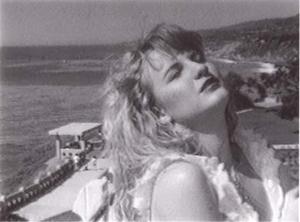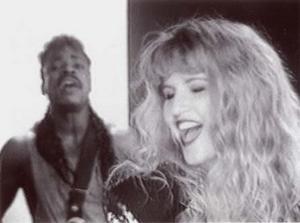|
|
|
Indoor/Outdoor
 |
| Super-8 Music Video - Body Glove |
Daytime Exterior Shots.
For more Information
on my 20 plus years
making films and videos,
please visit Alex LOGIC.
I am also an ideas person,
and an excellent collaborator.
Exteriors are usually an ally to the Super-8 filmmaker. Exteriors allow for quick set-up times. Super-8 cameras are so portable and easy to operate that moving to a new location usually requires a minimal amount of time. The result is more filming can be done in a typical work day. Because Super-8 film comes in pre-loaded cartridges, film changing bags are not necessary. By focusing your cinematography primarily on your actors, the background setting can many times be minimized and in theory the backgrounds should not be as noticeable as if one were shooting in 16mm or 35mm or video. A shiny board or two (aka foam core), will come in handy to help balance out harsh shadows when shooting exterior close ups of your actors.
Film Stock Options for Outdoor, Sunny Days. If you are in an open area, I recommend Velvia, Ektachrome 100D, Vision2 200T, and Ektachrome 64T, in that order. However, if you are filming outdoors and there are buildings and trees casting shadows, I would recommend Vision2, 200T as your first choice. If you have to limit your film stock choices, Kodak Vision2 200T is probably the most versatile Super-8 film you can use. The film stock with the least amount of grain and which can sometimes look like 16mm is Fuji Velvia Super-8 & Kodak Ektachrome 100D Super-8. These two fine super-8 film reversal film stocks are sold by Spectra Film and Video in North Hollywood California. Additionally, Kodak Ektachrome 64T is a bit of a hit or miss stock when it comes to grain. The color reproduction is fantastic but sometimes there is a touch more grain then when would like to see in a low ASA Reversal Super-8 film stock, yet there are times when the Ektachrome 64T looks less grainy.
|
shot.jpg) |
| Super-8 Music Video Body Glove |
The Advantage of Shooting Indoors.
Uninterrupted access to an interior location for an extended period of time can really save a lot money. An interior location where lights can be set up over and safely left overnight and for a few days or even weeks at a time when necessary allows for the low budget filmmaker to preserve lighting and set continuity, and should result in cost savings as less labor is required to reset up the same lights doing the same thing.
WARNING! Please don't leave any lights plugged into any wall sockets overnight or when no one is supervising the location. LOWER any lights that are on stands all the way down to their lowest position, make sure your light stands are sandbagged to help prevent them from tipping over and make sure that your interiors location will be left untouched and untraveled by those not involved in the production.
An overhead lighting grid usually allows for the most flexibility when it comes to filming because there are no light stands to to get in the way. Once again, extreme caution must be taken to to avoid fire hazards. An actual fire marshall may need to be present at all times, or at the very least, an inspection of the location by a certified fire marshall or electrican is advised, perhaps even daily if that can be arranged. Don't leave lights unattended and make sure they are a safe distance from walls and any material that could burn if the lights came close enough to them. A master power switch that can turn off all power at once is encouraged. And of course, don't shoot on overcrowded conditions and make sure there are plenty of exits and have a couple of tested and properly working fire extinguishers within reach, and make sure more than one or two people know how to use those fire extinguishers. Always know the exact street address you are filming at and what city you are in so any call to an emergency service can be handled in the most efficient manner possible.
Kodak's Vision negative film stocks, Vision 200T and Vision 500T now allow a filmmaker to shoot with much less lighting requirements, bravo Kodak!
Benefits of Having an Interior Location for more than one Day. If you are able to leave lights at a location safely, one might be able to actually get the film processed and transferred, perhaps even quickly edited, to determine if anymore shooting is needed before the location is broken down and all lights are removed.
|
 |
| Super-8 Music Video Body Glove |
Minimizing Backgrounds Can Reduce your Budget...
Super-8 offers a strategic difference when compared to 16mm and 35mm so generally speaking it's never really an issue as to whether or not to shoot in 16mm or Super-8 since they both accomplish different goals. When shooting Super-8 you will probably choose to minimize the background imagery as a way to reduce the need for background props, set design, and location releases. Minimizing the significance and clarity of the background should speed up the production schedule. Minimizing the background can also be a good thing if your film project is designed to "launch" an acting talent. By focusing the attention on the foreground and the actor the filmmaker is "featuring" their talent front and center. This creates a potential "win win" for the ultra low budget filmmaker/director and budding actor trying to get their careers off the ground. I'm not advocating avoiding getting film permits when filming, but the smaller the crew the less likely you are to be a distraction to others.
It's important to note that backgrounds are actually one of the most important aspects of most "professional" productions. As an E.N.G. cinematographer myself I always study what my background is and won't hesitate to reframe my shot if I feel the background clashes with my subject or the subject matter in an unflattering or confusing manner. When shooting a feature film in Super-8 the general idea is to tell the story through the actors and their emoting. Hence, if the background is minimized Super-8 holds the unique advantage of actually being both actor friendly and low budget filmmaking friendly as well.
Just how big of a crew would you use in a Super-8 production before switching to 16mm or 35mm? The more dialogue your movie has, the more you must have a competent sound engineer along with a sound assistant to handle the microphone boom. When we factor in the D.P. (director of photography), a lighting assistant to the DP, (aka gaffer or grip or both if you are using a dolly), and a make-up & hair person suddenly the temptation becomes great to shoot in 16mm because the daily expense for crew personnel has started to rise above the actual cost of film, processing and transfer.
16mm, even though it has less depth of field than Super-8, will still have better resolution in regards to the out of focus background than Super-8 will. The 16mm film crew size can continue to increase as all the smaller but essential details about your backgrounds are dealt with. Suddenly, in 16mm, the background matters more, more set design is usually required, which can also lead to more props. Larger equipment cases are needed for transporting camera and camera accessories, battery power and film stock. Consider the additional space requirements all of these accessories require and the 16mm guerilla film has now turned into a more conventional 16mm production. This can be viewed as a win win. In 16mm, you will get a really beautiful look, if you stay in Super-8, you will be shaving your budget. Either way, you will have the look of film because you shot on film rather than trying to make mini-dv or consumer Hd look like film later on. Additionally, by shooting on film, you have the luxury of transferring your film to ANY video format in existence, even ones that haven't been released yet but will be in the near future! If you study movies that are shown on HBO and Showtime, movies that were made in the 60's, 70's, and 80's, you will probably notice that they look better than ever, how did that happen? As the quality of digital video continues to improve, so does the look of film on those same digital video formats.
Super-8mm.com - Super-8mm Low Budget Feature Filmmaking Techniques
Page-1 Super-8 Links, Overview & Methods.
Page-2 Super-8 Guerilla Filmmaking.
Page-3 Indoor & Outdoor Locations.
Page-4 Super-8mm Film Stock Strategies.
Page-5 Super-8 Production News & Notes.
Page-6 A Good SoundTrack Can Make Your Film.
Page-7 Using Quiet Super-8 Cameras.
Page-8 Best Script Concepts for Super-8mm.
Page-9 Acquiring Same Model Super-8 Cameras.
Page-10 One Stop Super-8 Film Labs.
Super-8mm.net - The Many Advantages of Super-8mm Filmmaking are Revealed.
Page-1 Super-8mm Overview.
Page-2 Super-8mm Film Advantages Explored
Page-3 Super-8mm Film Production News
Page-4 Music Video Techniques.
Page-5 Labs & Transfers.
Page-6 8mm Film Subscription Magazines.
Page-7 Flicker Super-8 Shooting Strategies
Page-8 Using Polaroids.
Page-9 Super-8 Cameras.
Page-10 Super-8 Forums.
|
|
|
|
|